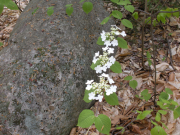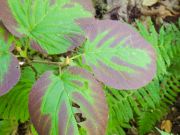Signs of impending winter are everywhere. Kettles of broad-winged hawks have begun their migration southward. The Fjord horse I ride is more aggressive about snagging mouthfuls of leaves or grass whenever we are on a trail and her coat is thicker and fuzzier every day.Those of us who heat with stoves are making sure our wood is stacked or stored.
The rising sun has moved from the left to the right side of the window over the stove. Gardeners are weeding and mulching, bringing in pots. Morning temperatures, now lower than that of the water in rivers and lakes, are causing thick fog to rise.
Splashes of red color the hillsides as deciduous shrubs and trees respond to nature’s signals. Although the hours of daylight have been declining since the summer solstice, suddenly it’s clear that the sun has crossed the celestial equinox and there is more dark than light.

Because this is my favorite time to walk I’ve been spending time on trails and country roads; hence my renewed interest in the humble hobblebush (Viburnum lantanoides). Anybody who has hiked a narrow mountain trail or bushwhacked in northern New England forests knows how the hobblebush earns its name.
This understory shrub’s gangly, low, sprawling branches not only shoot out horizontally in two directions, but tend to root themselves if the tip touches the ground. So, yes, it can be an annoying plant when it trips you or traps you, but there is much to admire in the plant’s beauty and clever strategies.
Let’s start with its blooms. Lovely large bright-white clusters emerge at the end of long branches — a welcome sight in early May. The structure of the flower resembles others with disc-shaped clusters (picture daisies and asters), but a closer look reveals a more complex structure. At the center is a dense bunch of dozens of tiny florets, each a complete flower with its own stalk, stigma and anthers. Surrounding them are larger, five-petaled sterile flowers, each about an inch across. Biologists believe that these showy blooms attract pollinators to the fertile flowers at the center.
As the summer progresses the blossoms develop into clusters of berries which ripen from their original green to pink, then red, and finally black. The berries are edible and, in their black and wrinkled form, considered tasty.

Now consider the leafing habit of the hobblebush. As a deciduous understory denizen the hobblebush is one of the first forest plants to put out leaves. We’ve already acknowledged its ability to extent its branches way out horizontally so its large leaves can gather the sunlight. The surprise begins near the end of summer when those old leaves begin to turn a burgundy color and drop. At that time a second set of leaves emerges from new buds. These fresh leaves arrive when the forest canopy is thinning, so even though they are small they capture whatever sunlight is available. Clever, eh?
Now the final surprise. When the smaller leaves wilt and fall the hobblebush produces another set of leaf buds which will stay on the plant through the cold of winter. These leathery brown buds resemble miniature moose ears, which is why hunters sometimes call the plant “moosebush.”
Of course, the hobblebush would grow very differently if it weren’t competing for space and light on the forest floor. The specialists at Eastern Plant, a rare plant nursery in Georgetown, Maine, argue that hobblebush is a great choice for landscapers in New England because it is difficult to propagate using conventional methods, it is rarely offered by other nurseries. They claim it is a very hardy and care free plant requiring only filtered light, damp soil and patience.
Here’s a tantalizing descriptions from their Web site: “This is a very attractive plant when grown correctly. Its overall form is a layered branch look, like a dogwood. When young it is very erratic with branches going everywhere but not many of them! Be patient, as it will mature into a fine shrub with tremendous branch appeal. It is very long lived as I have some 30 years old that are still going strong. The beautiful dormant buds… nothing else has the distinctive copper colored buds this has …a winter feature that adds color to the landscape.
To share questions, stories, comments or photographs contact AndoverNaturally @gmail.com